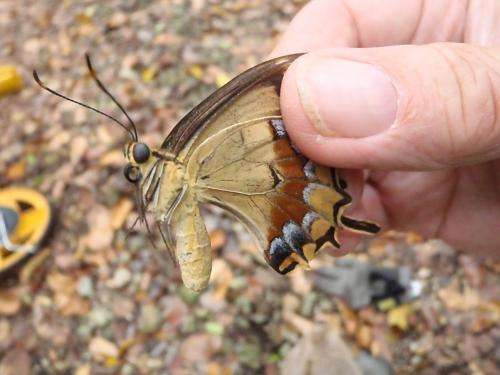Butterfly on the brink: First Schaus female found in a year raises hope for revival of species

The fate of a species may rest upon a single butterfly captured in late May by University of Florida lepidopterists. A UF research technician netted a female Schaus swallowtail in Biscayne National Park on Elliott Key, the first capture of a female since a multi-agency work group got a permit to do so last year.
The Schaus population has declined so much that last year the U.S. Fish and Wildlife Service (Service) issued UF an emergency permit to collect eggs.
That effort ended without a single female sighting last summer but got off to a promising start this spring when the female was captured May 21. From her, field researchers collected a single egg, which she laid May 23 before being released the next day.
The larva that hatched was taken to Gainesville last week, where it will join several other Schaus swallowtail larvae collected from the Keys.
"This single female could help bring the Schaus back from the brink," said Jaret Daniels, professor in UF's Department of Entomology and Nematology and associate curator of lepidoptera at UF's Florida Museum of Natural History. "The larva from her egg, combined with the other larvae we found in habitat preserved by Biscayne National Park, gives us the chance to help safeguard a portion of the remaining population."
Pending discussions with the Service and other conservation partners, UF stands ready to start a breeding program.
The Schaus once proliferated throughout much of extreme southeastern Florida. There are varying explanations for its decline, including drought, insecticides and habitat loss from development. It was federally listed as an endangered species in 1984. According to Biscayne National Park Superintendent Brian Carlstrom, "The undeveloped keys within Biscayne National Park provide a last refuge for the Schaus where pesticides are not sprayed and native host plants are both protected and restored."
Because of its iconic status, the Schaus was once featured on a U.S. postage stamp. It's considered the flagship species for the health of what's known as tropical hardwood hammock habitat, the proverbial canary in the coal mine whose decline can sound a warning about the health of other species.
UF arguably saved the Schaus from extinction in 1992, when the Service and the Florida Fish and Wildlife Conservation Commission granted UF museum researchers permission to capture females to launch a breeding program in Gainesville. Then in August of that year, Hurricane Andrew nearly wiped out the wild population and temporarily destroyed most of its habitat. UF ultimately released thousands of lab-bred butterflies into the wild.
With the population again in peril, the Service, the National Park Service, FWC, the North American Butterfly Association and UF agreed in 2010 to cooperate on intensive population surveys. The Service is providing $32,000 to fund the search for the Schaus. The NPS is providing boat transportation and housing for researchers, along with technicians to assist with finding butterflies. The Ocean Reef Conservation Association donated a golf cart through the South Florida National Parks Trust to transport researchers on the island. FWC is also providing scientific support.
Last year, field crews found four butterflies, but no females after the capture permit was issued. The recent capture was the first to result from a search that began in mid-April.
"This is a breakthrough," said Mark Salvato, a Service biologist. "We're backing the efforts of UF's Florida Museum of Natural History because it has the expertise to manage such a delicate operation and because of its long commitment to saving the Schaus."
While the partners agree that finding one female and several larvae doesn't put concerns about this species' survivability to rest, the discoveries merit some relief and hope.
"Kudos to the University of Florida team that found her and is nurturing the larvae," said Larry Williams, the Service's Florida state supervisor for ecological services. "But our work is ongoing. We're going to keep searching as long as we can. The despair we felt last year has been replaced by hope."
Provided by University of Florida
















